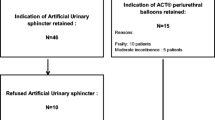Abstract
Purpose
To report the outcomes of AUS in women with neurological SUI resulting from intrinsic sphincter deficiency after a follow-up from 3 to 20 years.
Methods
The charts of female with moderate to severe neurological SUI who underwent open or laparoscopic AUS implantation between November 1994 and July 2014 were reviewed retrospectively. All patients were operated by a single experienced surgeon. Primary endpoint was a postoperative continence categorized as complete continence (no pads used), improved incontinence or unchanged incontinence.
Results
Twenty-three women (mean age 54 years, range 19–77) underwent open or laparoscopic AUS implantation. At the last follow-up, 7 (30.4%) initial artificial urinary sphincters remained in situ and 9 (39.1%) patients had at least one revision or reimplantation. Sixteen patients were fully continent (69.6%), four (17.4%) had improved incontinence and three (13.0%) had unchanged incontinence. After a median follow-up of 11.6 years (3–22), 8 (34.8%) explanations in 7 patients and 16 (69.6%) revisions in 11 patients occurred. The average time without explanation or revision was 10.9 and 8.5 years, respectively. Survival rates without AUS explanation were 94.4%, 76.5%, 72.8%, 50% and without revision were 83.3%, 64.7%, 45.5% and 16.7% at 5, 10, 15 and 20 years, respectively.
Conclusion
Although all methods are imperfect at best, AUS remain toward our experience a good way to achieve long-term continence in female patients suffering from neurological SUI with preserved manual dexterity.


Similar content being viewed by others
References
Phé V, Léon P, Granger B et al (2017) Stress urinary incontinence in female neurological patients: long-term functional outcomes after artificial urinary sphincter (AMS 800TM ) implantation. Neurourol Urodyn 36:764–769. https://doi.org/10.1002/nau.23019
Reus CR, Phé V, Dechartres A et al (2018) Performance and safety of the artificial urinary sphincter (AMS 800) for non-neurogenic women with urinary incontinence secondary to intrinsic sphincter deficiency: a systematic review. Eur Urol Focus. https://doi.org/10.1016/j.euf.2018.10.009
Groen J, Pannek J, Castro Diaz D et al (2016) Summary of European Association of Urology (EAU) guidelines on neuro-urology. Eur Urol 69:324–333. https://doi.org/10.1016/j.eururo.2015.07.071
Light JK, Scott FB (1985) Management of urinary incontinence in women with the artificial urinary sphincter. J Urol 134:476–478
Ferreira C, Brychaert P-E, Menard J, Mandron E (2017) Laparoscopic implantation of artificial urinary sphincter in women with intrinsic sphincter deficiency: mid-term outcomes. Int J Urol 24:308–313. https://doi.org/10.1111/iju.13296
Biardeau X, Rizk J, Marcelli F, Flamand V (2015) Robot-assisted laparoscopic approach for artificial urinary sphincter implantation in 11 women with urinary stress incontinence: surgical technique and initial experience. Eur Urol 67:937–942. https://doi.org/10.1016/j.eururo.2014.12.041
Peyronnet B, Capon G, Belas O et al (2019) Robot-assisted AMS-800 artificial urinary sphincter bladder neck implantation in female patients with stress urinary incontinence. Eur Urol 75:169–175. https://doi.org/10.1016/j.eururo.2018.07.036
Patrick DL, Martin ML, Bushnell DM et al (1999) Quality of life of women with urinary incontinence: further development of the incontinence quality of life instrument (I-QOL). Urology 53:71–76. https://doi.org/10.1016/s0090-4295(98)00454-3
Tricard T, Jochum F, Bergerat S et al (2019) Outcomes of open artificial urinary sphincter in women with stress urinary incontinence: long-term follow up. Ther Adv Urol 11:1756287219874676. https://doi.org/10.1177/1756287219874676
Mandron E, Bryckaert P-E, Papatsoris AG (2010) Laparoscopic artificial urinary sphincter implantation for female genuine stress urinary incontinence: technique and 4-year experience in 25 patients. BJU Int 106:1194–1198. https://doi.org/10.1111/j.1464-410X.2010.09206.x(discussion 1198)
Hampel C, Artibani W, Pons ME et al (2004) Understanding the burden of stress urinary incontinence in Europe: a qualitative review of the literature. Eur Urol 46:15–27. https://doi.org/10.1016/j.eururo.2004.02.003
Dmochowski RR, Blaivas JM, Gormley EA et al (2010) Update of AUA guideline on the surgical management of female stress urinary incontinence. J Urol 183:1906–1914. https://doi.org/10.1016/j.juro.2010.02.2369
Vayleux B, Rigaud J, Luyckx F et al (2011) Female urinary incontinence and artificial urinary sphincter: study of efficacy and risk factors for failure and complications. Eur Urol 59:1048–1053. https://doi.org/10.1016/j.eururo.2011.03.006
Venn SN, Greenwell TJ, Mundy AR (2000) The long-term outcome of artificial urinary sphincters. J Urol 164:702–706 (discussion 706–707)
Thomas K, Venn SN, Mundy AR (2002) Outcome of the artificial urinary sphincter in female patients. J Urol 167:1720–1722
Costa P, Poinas G, Ben Naoum K et al (2013) Long-term results of artificial urinary sphincter for women with type III stress urinary incontinence. Eur Urol 63:753–758. https://doi.org/10.1016/j.eururo.2012.03.008
Petero VG, Diokno AC (2006) Comparison of the long-term outcomes between incontinent men and women treated with artificial urinary sphincter. J Urol 175:605–609. https://doi.org/10.1016/S0022-5347(05)00243-0
Phé V, Benadiba S, Rouprêt M et al (2014) Long-term functional outcomes after artificial urinary sphincter implantation in women with stress urinary incontinence. BJU Int 113:961–967. https://doi.org/10.1111/bju.12360
Chung E, Cartmill RA (2010) 25-year experience in the outcome of artificial urinary sphincter in the treatment of female urinary incontinence. BJU Int 106:1664–1667. https://doi.org/10.1111/j.1464-410X.2010.09419.x
Peyronnet B, O’Connor E, Khavari R et al (2018) AMS-800 artificial urinary sphincter in female patients with stress urinary incontinence: a systematic review. Neurourol Urodyn. https://doi.org/10.1002/nau.23833
Peyronnet B, Vincendeau S, Tondut L et al (2016) Artificial urinary sphincter implantation in women with stress urinary incontinence: preliminary comparison of robot-assisted and open approaches. Int Urogynecology J 27:475–481. https://doi.org/10.1007/s00192-015-2858-7
Acknowledgements
All authors have read and approved the paper.
Author information
Authors and Affiliations
Contributions
TT: project development, data collection, data analysis, manuscript writing. AS: data collection, data analysis, manuscript writing. PM: critical revision of the manuscript. CS: critical revision of the manuscript. AS: critical revision of the manuscript.
Corresponding author
Ethics declarations
Conflict of interest
The authors have no conflicts of interest to declare.
Ethical standards
All procedures performed in studies involving human participants were in accordance with the 1964 Helsinki declaration and its later amendments or comparable ethical standards.
Research involving human participants
This article does not contain any studies with animals performed by any of the authors.
Informed consent
Informed consent was obtained from all individual participants included in the study.
Additional information
Publisher's Note
Springer Nature remains neutral with regard to jurisdictional claims in published maps and institutional affiliations.
Rights and permissions
About this article
Cite this article
Tricard, T., Schirmann, A., Munier, P. et al. Outcomes of artificial urinary sphincter in female with neurological stress urinary incontinence: a long-term follow-up. World J Urol 39, 157–162 (2021). https://doi.org/10.1007/s00345-020-03105-2
Received:
Accepted:
Published:
Issue Date:
DOI: https://doi.org/10.1007/s00345-020-03105-2




